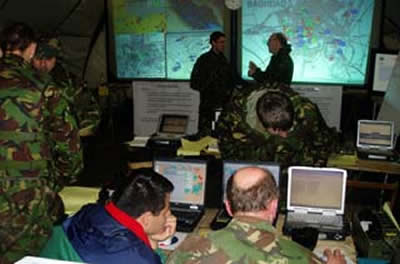For many years, land forces lagged behind air forces and navies in the implementation of computerized command, control, communications (C4) technologies. Complex operating environment, standardization issues, limited mobility and lack of adequate data transfer capability, primarily at the tactical, narrow-band communications level, kept land forces away from using tactical integrated C4 systems, while systems deployed at higher echelons suffered from excessive latency, due to insufficient reporting from the field units.
Today’s land forces transformation is driven by a significantly better communications, more affordable, ruggedized and reliable computers, and advanced applications that are becoming an indispensable tool for leaders at all levels of command.
Communications Networking
Military communications benefit from the rapid growth of commercial communications and merging of mobile communications and IP (Internet Protocol) technology. Information, now accessible everywhere through wireless protocols, is becoming part of the military Commercial Off The Shelf (COTS) based communications infrastructure. These include cellular 3G wireless communications applications, adapted to military use and the modification of TETRA and TETRAPOL based communications systems, to provide thousands of military users with end-to-end secured communications, integration of Wi-Fi wireless local area networking and WiMAX to replace wire-line communications, connecting elements between and within command posts.
COTS Communications
Commercial standards are also used in discrete applications, including datalinks, which previously relied on proprietary technologies. One example is the Coded Orthogonal Frequency Division Multiplexing (COFDM) technology, originally developed for digital TV and cable broadcasting, now used to support military applications requiring multiple live video feeds.
This feature continues to cover the following topics:
- Tactical C4 Networking Challenges
- Building Blocks of C4 Systems
- Vehicular C4 Applications
- C4 for the Battalion Level
- Situation Assessment Tools For Dismounted Leaders
- Brigade’s Tactical Operations Center
- Common Operation Picture (COP)
- The Modern Command post
- C4 Networking Architecture
- Mission planning Tools




















